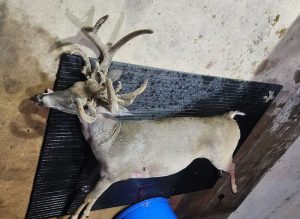Nine days after the animal had its ovaries removed; reports came into officials regarding a deer in distress in downtown Ann Arbor. According to reports, White Buffalo Inc., the company hired to carry out the sterilizations’ President Tony DeNicola responded and eventually chose to euthanize the animal given its poor state of health.
The deer, earmarked as number 32, is one of 54 Ann Arbor deer that were subjected to the invasive sterilization surgery in an attempt to curb the city’s growing deer population in a humane way. While the exact cause of death has yet to be determined, officials are hopeful it has little to do with the surgery.
“Upon examination, the sterilization incision appeared to be healed and was not infected and there were no signs of bleeding, discharge or trauma,” according to an incident report shared by the city.
“However, because the animal was in distress, Dr. DeNicola decided that the humane course of action was to euthanize the deer by injection.”
The animal was transported the doe Diagnostic Center for Population and Animal Heath at Michigan State University, where a full necropsy is scheduled for later today to determine the cause of death.
This was not the first incident involving deer 32 either. Last weekend, the same deer was spotted standing in the middle of Arlington Boulevard while other reports also indicated the very same deer was overly friendly and approaching vehicles without caution.
A common side effect of any capture and release project is obvious trauma to the animal along with the possibility of reducing the animal’s fear of human activity. While these risks are not strictly reserved for fertility control projects like this one, they are certainly higher as activities such as surgery are introduced. As many capture and release projects are intended for tagging and population management, the stress to the animal is considerably less than compared to, say, removing an animal’s ovaries.
The question many of us have is; will this continue to be a trend for these experimental sterilization projects, of which, we are sure to see many more of?
The answer is unfortunately not that cut and dry as we have yet to have the ability to compile any long-term data, given the immaturity of these experiments.
Even through disagreement, I regard a certain amount of respect for those looking for a humane way to manage deer populations in urban centers. None of us want to see these animals suffer in any way.
My personal fear is that we might just be rushing into these sterilization projects without a terrible amount of sound reasoning other than the often well-intentioned, but ill-informed protests of animal rights advocates.
Time will certainly be the indicator as to how many if any; more deer will be found suffering due to these experimental programs. As a hunter, wildlife advocate and conservationist, I will certainly be paying attention.
Image: Michigan DNR




